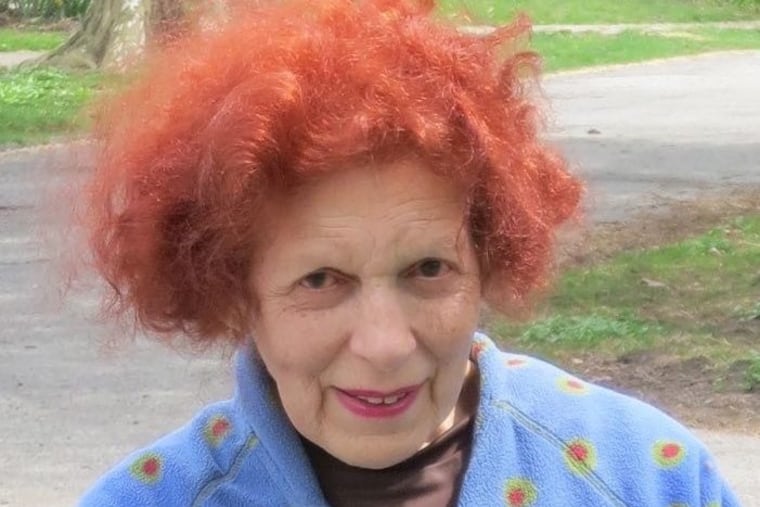Victoria Donohoe, 89, longtime Inquirer art critic and Narberth historian
Miss Donohoe was respected for her vast knowledge of the art world. Plus, when she had something to say in her Inquirer column, The Arts Scene, that was critical, she did it gently.

Commuters on the Paoli/Thorndale Regional Rail line may recall Victoria Donohoe, a small woman with bright red hair, moving slowly down the aisle when the train pulled to a halt in Narberth.
Wearing her customary hat, plaid suit, and pearls, she typically greeted fellow riders in a soft, musical voice. Many on the platform seemed to know her. She was much loved in the borough.
Miss Donohoe, 89, an artist and historian as well as a freelance Inquirer art critic for 50 years, died Wednesday, Nov. 21, of pneumonia at Westgate Hills Rehab & Nursing Center in Havertown, where she had been since June 19. Before that, she had lived in her family's historic home in Narberth.
Gabriel Escobar, editor and vice president of Philadelphia Media Network, publisher of the Inquirer and Daily News, called Miss Donohoe's dedication to art criticism "a remarkable achievement."
"For 50 years," Escobar said, "Inquirer readers benefited from her insights and from her disciplined approach to her craft. She was also indomitable. In her later years, there was an aura of legend about her.
"After a trip that often required multiple modes of transport, she would settle at a computer terminal at the newsroom in Conshohocken and carefully, methodically, enter her prose. She would announce when she was done, wait patiently for an edit, and then pack up and make the long trek home. She was grace personified."
Rebecca Klock, a former fine arts editor of the Inquirer, was Miss Donohoe's supervisor.
"Victoria spanned half a century of Inquirer history, her flaming red hair and impeccable designer suits a welcome sight to gallery owners as far away as Lancaster, Bethlehem, and Princeton," Klock said.
"She was a true gentlewoman, well-spoken and gracious, with beautiful calligraphic handwriting that was shown to great advantage in the lovely notes she wrote at the slightest provocation. Computers fuddled her; she didn't do email. She didn't even have an answering machine. If you wanted to communicate with Victoria, you did it in person."
Mary Gillespie of East Goshen, a second cousin who saw Miss Donohoe at family gatherings, said the art critic never learned to drive and relied on SEPTA. "My husband would pick her up at the station," Gillespie said. "She would always be there, beautifully dressed. She always made the effort."
Miss Donohoe had no TV, air-conditioning, or computer at home. When she needed to file her column, she would appear in the Inquirer suburban newsroom in Conshohocken. There, she would ask a staffer to log her into the publishing system, and then she would type the piece from handwritten copy.
Despite the tricky logistics, she was a productive writer. Over a career from 1962 to 2012, when she retired, she wrote more than 1,000 articles, said Ted Goldsborough, a neighbor of Miss Donohoe's who helped manage her affairs in her later years. Many of her reviews are on file at Rosemont College, her alma mater.
"The ground she covered and the research she did was remarkable," he said.
No matter what the weather was, when there was an art show to be reviewed, Miss Donohoe would get there by public transit, notebook and pen in hand. She made friends with many artists and corresponded with them.
"Her insightful but honest interpretations of their work earned her respect throughout the art world," wrote a group of neighbors who were her close friends.
Miss Donohoe was frank about how she viewed the paintings, prints, or sculptures she reviewed in her column, but if she had to criticize, she did so gently.
In September 2009, when reviewing Rebecca Rutstein's Precipice exhibit at the Bridgette Mayer Gallery in Philadelphia, she wrote: "These acrylics with their often beautiful color and tracery of line aren't terribly venturesome things, but they make us want very much to see more of her work."
When the exhibit was a winner, she said so. "The Vincent van Gogh Exhibition at the Philadelphia Museum of Art is stunning and comprehensive," she wrote in March 1970. "It features the art of a Dutchman who was despised and rejected in his lifetime, but whose work has since attained worldwide popularity and a lasting place in art history."
Miss Donohoe was well placed to become an art critic. Her father, Daniel, was an artist at the Evening Bulletin and her mother, Anne, taught at Moore College of Art and Design, Gillespie said.
Miss Donohoe graduated from Merion Mercy Academy and received a bachelor's degree from Rosemont College in 1950. She went on to earn a master of fine arts degree from the University of Pennsylvania.
In the early 1950s, she tried painting and turned out landscapes, still lifes, and portraits, according to her neighbors. In 1953, she studied art in Florence, Italy.
In 1985, Miss Donohoe was given an honorary doctorate in fine arts by Villanova University. She was also honored in 2013 by the Philadelphia Tri-State Artists Equity Association, a professional group.
Another interest was historic preservation. In 1998, Miss Donohoe successfully lobbied the Pennsylvania Historic and Museum Commission for a roadside marker in Narberth honoring former NFL commissioner Bert Bell, a borough resident.
She also went to bat for John Dickinson, author of the Articles of Confederation. Because of her work, the commission placed a marker honoring Dickinson on Montgomery Avenue, Narberth, in 2001.
In 2003, she was able to get Narbrook Park, a planned neighborhood of 25 homes built from 1915 to 1938, placed on the National Register of Historic Places. "Everything for Vicky was about Narberth," said Goldsborough. "She will be missed."
There were no immediate survivors.
A Funeral Mass will be held at 10:30 a.m. Friday, Nov. 30, at St. Margaret Church, 208 N. Narberth Ave., Narberth. Interment is private.